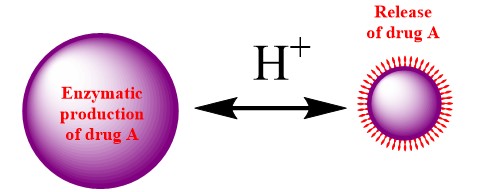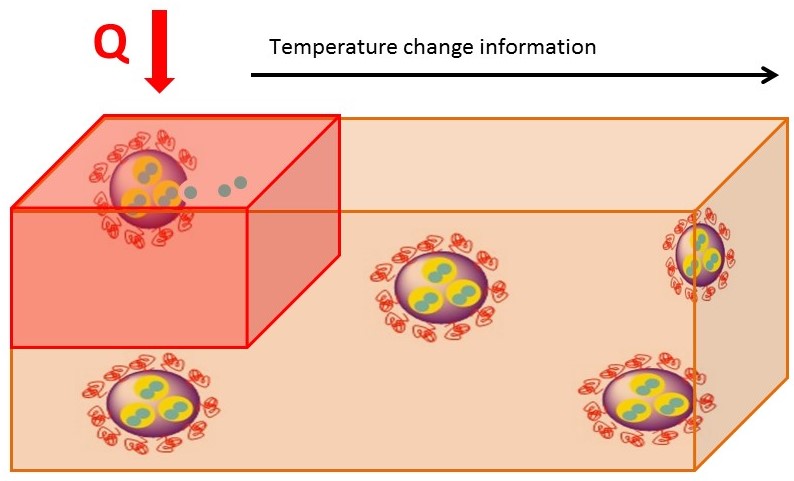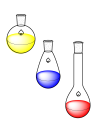Research Interest
April 28, 2012polymeric materials coupled with Autocatalytic reactions
Hydrogels containing Ruthenium complex catalysts

Poly(NIPAAm) based gels containing a ruthenium complex were prepared for first time by Professor Ryo Yoshida. The ruthenium moiety that is covalently bonded to the polymer backbone, acts as catalyst for the oscillating Belousov-Zhabotinsky (BZ) reaction. When the gel is immerse in a solution containing this reaction reactants, the reaction starts and the ruthenium changes rhythmically its oxidation state. As the oxidation state changes, the hydrophilicity of the gel changes as well; inducing volume changes of the gel. In 2013, Professor Balazs predicted, using numerical simulations, that four cubic gels arranged in a square will rotate clockwise or anti-clockwise.
My interest relies in the use of BZ gels for two purposes: a) to construct self-organizing micromachinary controlled by light and b) to analyze the quorum sensing properties between BZ gels for the understanding of biofilm formation.

The Belousov-Zhabotinsky reaction involves the oxidation of an organic acid by bromate ions in acidic medium and in the presence of a catalyst. This reaction exhibits a rich dynamics similar to neural activity. We use the BZ reaction as a model for excitable biological systems.
Hydrogels containing enzymes

Hydrogels that contain carboxylic or ammonium moieties can swell/deswell by pH variations of the environment. By coupling this pH sensitive gel with a pH oscillator, we can obtain a rhythmically volume changing material, capable of releasing drugs. Usual pH oscillators contain halogens, sulfur or transition metals that are not safe for the use of drug delivery in humans. Therefore, there is a need to build biocompatible pH oscillators.
Enzymes offer us a large possible number of combinations among them to design an enzymatic oscillating network capable of producing therapeutic drugs. My aim is to couple a minimum of four enzymes in which one will increase the pH of the solution, the second one will bring the pH down, the third one will produce the drug of interest and the fourth enzyme will regulate the concentration of the drug within the composite. The substrates for the enzymes should be available in the environment; therefore the drug will be synthesize in-situ and no loaded in the hydrogel as in conventional drug delivery systems.
Chemo-thermo actuators

I am looking to develop chemo-thermo actuators which I define here as composite materials that mechanically respond to temperature changes activating or producing a chemical signal. This chemical signal can be manifested as regular oscillations, bursting or chaotic behavior of chemical species-concentrations depending on the temperature perturbation.
The proposed chemo-thermo actuator (left figure) contains microcapsules within a hydrogel. These capsules have a shell made of a thermo-responsive polymer and contain the activator species necessary for an oscillating reaction to occur within the gel. As the local temperature of the gel changes, the capsules release the reagents that will initiate the oscillating reaction; when the reaction starts, the gel will swell-deswell helping to the diffusion of the reactants and intermediates through the gel.
stabilization of scroll waves in an excitable medium in the presence of heterogeneities

Ventricular fibrillation is thought to be a result of the presence of one mother rotor or the interaction of simultaneous rotors in the heart muscle in a disordered state. Such rotors are cores of two-dimensional spiral waves and filaments (coupled cores) of three-dimensional scroll waves (left figure). The presence of the rotors can change the electrical wave propagation profile producing the arrhythmia. The stabilization of these rotors in the heart may occur by their interaction with fibrotic or scar tissue originated during cardiac remodeling. The stabilized electrical waves can take the form of spiral or scroll waves depending of the thickness of the cardiac tissue (ventricle vs atrium).

The cardiac tissue and the Belousov-Zhabotinsky (BZ) reaction are both excitable media. This common property is the foundation to study spiral and scroll waves in the BZ-medium, with the aim of understanding arrhythmias in the heart.
A nucleated scroll ring in an unstirred BZ reaction system (right figure) induces wave propagation (shown as whitish color bands) through the medium. When the scroll ring is stabilized by pinning, the alteration of the medium will continue indefinitively until the reactants are depleted.
These spiral or scroll waves can be stabilized by creating anchoring areas which are made of non-conductive tissue or inert obstacles (i.e. spherical obstacles, left figure).
My goal is to analyze the dynamics of these 3D patterns when pinned to heterogeneities that are partially inert; and also the dynamics when we apply physical, chemical or biological perturbations to the pinned waves. The stabilization, destabilization and interaction of anchored and/or free waves will provide information of how to eliminate them and prevent their formation perhaps in the heart.

